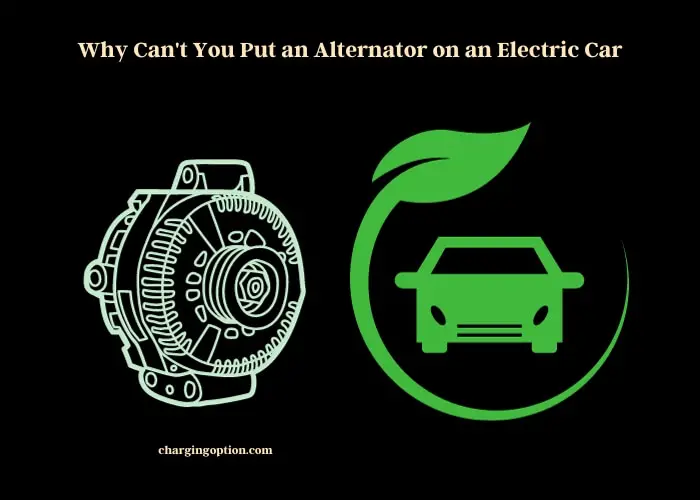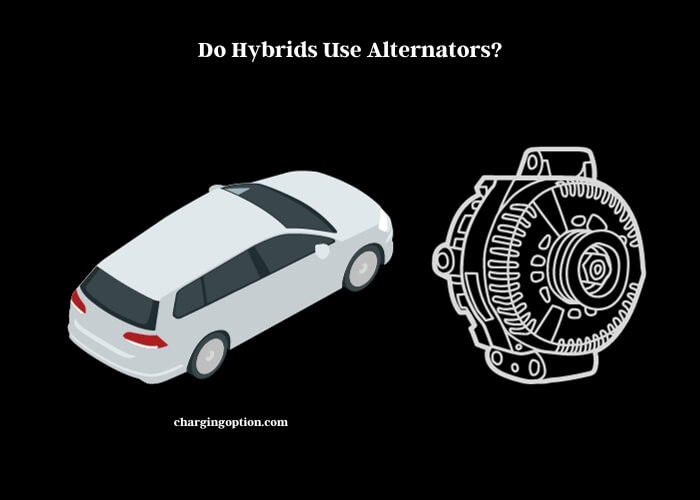Electric cars don’t require alternators because they don’t have traditional internal combustion engines. Alternators are designed to recharge the battery in conventional vehicles, not electric ones.
Electric vehicles (EVs) are fundamentally different from their gasoline-powered counterparts. The primary purpose of an alternator in gasoline vehicles is to convert mechanical energy into electrical energy, which then charges the car’s battery. Since EVs rely on large battery packs to power their electric motors, they don’t need alternators in the same way. Instead, they use onboard chargers and regenerative braking systems to recharge their batteries.

Many wonder why electric cars can’t charge themselves while driving. The concept seems simple: place an alternator on each wheel or have a built-in generator. Yet, this idea isn’t as efficient as it sounds. Regenerative braking, a feature present in many EVs including Teslas, captures some of the energy lost during braking and converts it back into electricity. This process is more efficient than having an alternator on each wheel.
The notion of an electric car that charges itself is enticing. While regenerative braking is a step in that direction, it doesn’t fully charge the vehicle. Hybrid cars, which combine gasoline engines with electric motors, do have a form of alternator, but it’s not the same as in traditional cars. The system in hybrids is more complex, ensuring that both the electric motor and gasoline engine work in harmony.
In essence, while the idea of self-charging electric cars is appealing, current technology and efficiency considerations make traditional alternators unsuitable for EVs.
Why Can’t You Put an Alternator on an Electric Car?
The Basics of Electric Cars and Alternators
What is an Alternator and Its Primary Function?
Ever turned the key in your car and heard it roar to life? Thank an alternator for that. In simple terms, an alternator is a device that transforms mechanical energy into electrical energy. It’s like a mini power plant for your car, ensuring the battery stays charged and the electrical systems run smoothly. Without it, your traditional car wouldn’t last long on the road.
The Fundamental Differences Between Electric and Gasoline Vehicles
Imagine two siblings: one loves rock music, the other jazz. They’re from the same family but have distinct tastes. Similarly, electric and gasoline vehicles come from the automotive family but have different energy needs. While gasoline vehicles rely on fuel combustion, electric cars use stored electrical energy. This fundamental difference dictates the components each vehicle type requires.
The Role of the Alternator in Traditional Vehicles
Converting Mechanical to Electrical Energy
Think of the alternator as the heart of a gasoline vehicle. Just as our heart pumps blood, the alternator pumps electricity. It takes the energy produced by the engine’s spinning and turns it into electricity. This electricity then charges the battery and powers the car’s electrical systems. It’s a continuous cycle that keeps the car alive and kicking.
Charging the Battery: A Vital Task
Without a charged battery, your car is just a hunk of metal. The alternator ensures the battery remains juiced up. Every time you drive, the alternator works tirelessly, ensuring the battery doesn’t deplete. It’s like having a personal chef who constantly refills your plate, ensuring you never go hungry.
Electric Cars: A Different Energy Ecosystem
The Powerhouse: Electric Car Battery Packs
Electric cars don’t have a plate of food; they have a buffet! Their large battery packs store vast amounts of energy, enough to power them for hundreds of miles. These packs are the lifeline of electric vehicles, eliminating the need for alternators. It’s like having a massive water tank in your house, so you don’t need constant refills.
Onboard Chargers and Their Role in EVs
Instead of alternators, electric cars have onboard chargers. Picture this: you’ve got a massive jug of water, but you need a faucet to use it. Onboard chargers act as that faucet, regulating and distributing the energy stored in the battery pack to the car’s systems. It’s a tailored approach for the unique needs of electric vehicles.
Regenerative Braking: The Electric Car’s Answer
How Regenerative Braking Works
Ever wished you could recycle wasted energy? Electric cars can! When you hit the brakes, instead of wasting that energy, regenerative braking systems capture it. It’s like catching rainwater in a barrel instead of letting it go down the drain. This captured energy then goes back into the battery, giving electric cars a slight recharge on the go.
Efficiency and Energy Recovery
Regenerative braking isn’t just cool; it’s efficient. While it doesn’t fully charge the car, it recovers a significant portion of the energy usually lost during braking. Imagine if every time you spent money, a small percentage magically returned to your wallet. That’s the kind of efficiency we’re talking about!
The Allure of Self-Charging Electric Cars
The Concept: Alternators on Each Wheel
Some folks dream of electric cars with alternators on each wheel, constantly charging as they drive. Sounds like a dream, right? But in reality, it’s not as rosy. It’s like expecting a windmill in your backyard to power your entire house. While it might help a bit, it won’t be the complete solution.
Why It’s Not as Efficient as It Sounds
Physics is a party pooper sometimes. Adding alternators to each wheel would create resistance, making the car work harder and reducing overall efficiency. It’s like running with weights on; you’ll tire faster. The idea is fascinating, but the practical challenges are significant.
Hybrid Cars: A Unique Blend of Technologies
The Dual System: Gasoline Engine and Electric Motor
Hybrids are the best of both worlds. They have a gasoline engine and an electric motor. It’s like having both a bicycle and a skateboard; you can switch based on your needs. This dual system allows hybrids to utilize features from both electric and traditional vehicles.
Do Hybrids Use Alternators?
Yes and no. While hybrids have components similar to alternators, they function differently. It’s like having a blender that can also toast bread. The device exists, but its role is adapted to fit the hybrid’s unique requirements.

Technological and Efficiency Considerations
The Challenges of Incorporating Alternators in EVs
Slapping an alternator onto an electric car isn’t a straightforward task. The design, weight distribution, and energy needs of EVs differ from traditional cars. It’s like trying to fit a square peg in a round hole; the pieces just don’t align perfectly.
Future Innovations and Possibilities
Who knows what the future holds? While today’s technology might not favor alternators in EVs, tomorrow’s innovations might find a way. Maybe we’ll find a way to harness energy more efficiently or design a new component altogether. After all, isn’t the sky the limit?
FAQs
What’s the Primary Function of an Alternator in Traditional Cars?
In conventional gasoline vehicles, the alternator plays a pivotal role. It acts like a mini power station, converting the engine’s mechanical energy into electrical energy. This electricity then powers the car’s various electrical components and ensures the battery remains charged. Without an alternator, the battery would deplete rapidly, causing the vehicle to stall.
Why Don’t Electric Cars Need Alternators Like Gasoline Cars?
Electric vehicles (EVs) operate differently from their gasoline counterparts. They rely on large battery packs to power their electric motors. These packs are designed to store significant amounts of electricity, eliminating the need for alternators. Instead of using alternators, EVs have onboard chargers and regenerative braking systems to recharge their batteries.
How Do Electric Cars Recharge Their Batteries?
Electric cars use onboard chargers to recharge their batteries. These chargers take electricity from external sources, like charging stations or home outlets, and feed it directly to the battery. Moreover, many electric cars feature regenerative braking, a system that captures energy usually lost during braking and redirects it back to the battery, further aiding in recharging.
Could Alternators Be Used to Make Electric Cars Self-Charging?
While the idea of a self-charging electric car is enticing, using alternators isn’t the most efficient method. Placing an alternator on each wheel or incorporating a generator might sound promising, but in practice, it introduces inefficiencies. The added weight and complexity could offset potential energy gains.
What’s the Deal with Regenerative Braking in Electric Cars?
Regenerative braking is an innovative feature in many electric vehicles. Instead of letting the energy go to waste when braking, this system captures some of that energy and converts it back into electricity, which is then stored in the battery. It’s a way for electric cars to reclaim and reuse energy, enhancing their efficiency.
Do Hybrid Cars, Which Use Both Gasoline and Electricity, Have Alternators?
Yes, hybrid cars, which combine the features of gasoline engines and electric motors, do have a form of alternator. However, it’s not identical to the ones in purely gasoline vehicles. In hybrids, the system is more intricate, ensuring the gasoline engine and electric motor work harmoniously without interfering with each other.
What Are the Main Challenges of Incorporating Alternators in Electric Cars?
Integrating an alternator into an electric car presents several challenges. Firstly, there’s the issue of weight. Adding an alternator could increase the vehicle’s weight, affecting its efficiency. Space is another concern, as electric cars are designed with specific components in mind. Lastly, the introduction of an alternator could disrupt the car’s existing electrical systems, leading to potential inefficiencies or malfunctions.
In the grand tapestry of automotive design, every component has its place. For electric cars, the absence of alternators is a conscious choice, rooted in efficiency and design considerations. As we cruise into the future, who knows what exciting twists and turns await on the road of innovation? One thing’s for sure: the journey is bound to be electrifying!
